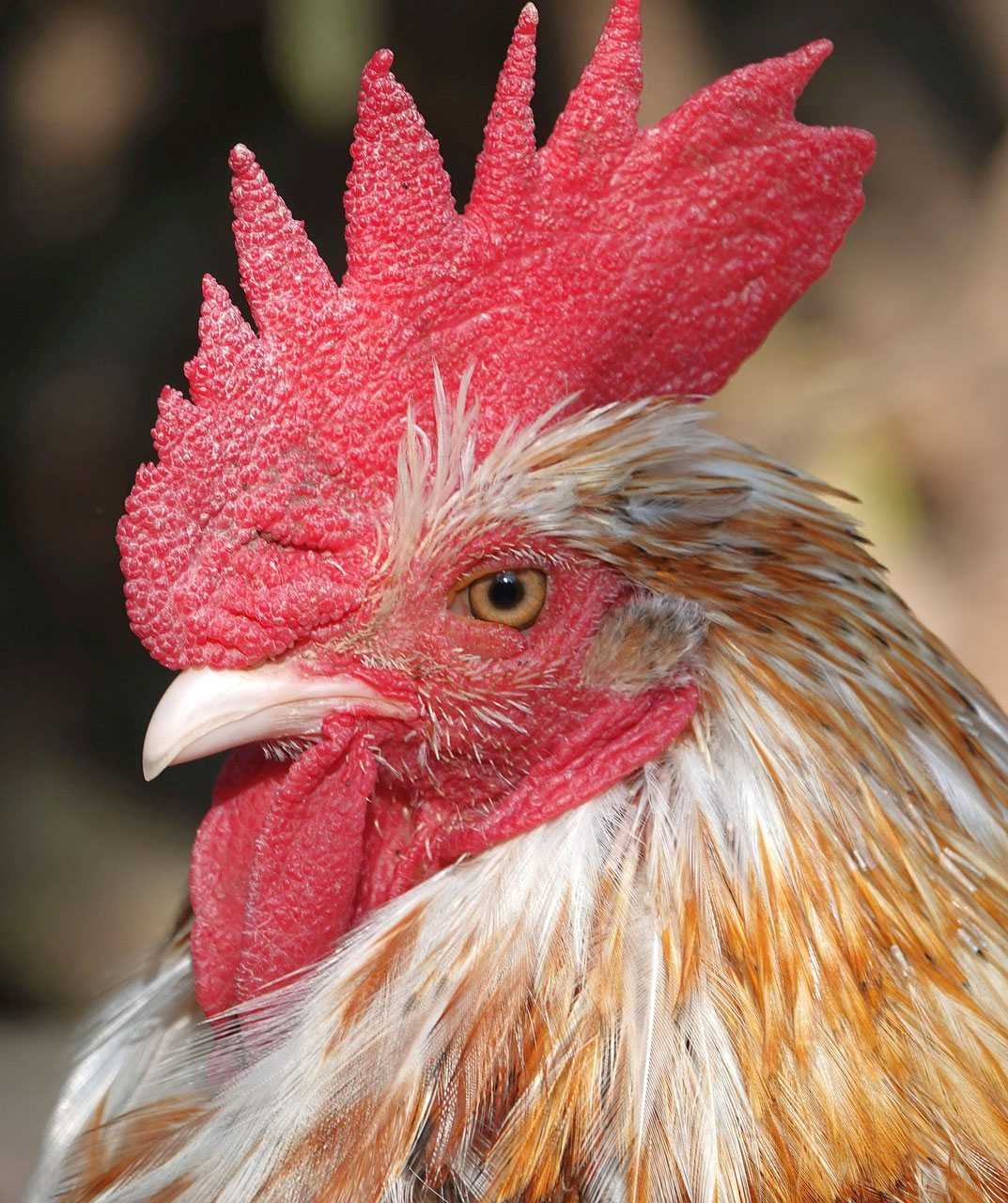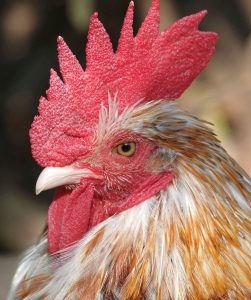
Like the males of 97 percent of all bird species, a rooster does not have a penis. An incubated egg that will become a rooster starts to develop a penis, but early in the second week of embryonic development, a cell death protein called Bmp4 cloaks the incipient penis, causing it to stop developing and instead remain as a rudimentary nub.
So how do chicken eggs get fertilized?
The rooster and hen kiss!
But not with their beaks.
The rooster injects sperm into a hen by pressing his vent against hers in a process known as the cloacal kiss. The cloaca is the chamber just inside the vent where the digestive, urinary, and reproductive tracts end.
The rooster’s cloaca contains two tiny nipples (papillae) at the ends of the two ducts that transport semen from the rooster’s testes. The testes are hidden inside the rooster, near his backbone, and look like a pair of large white beans. To transfer semen into a hen, the two cloacal papillae serve as the rooster’s mating organs.
During a cloacal kiss, the hen squats. The rooster does a balancing act on her back, and when everything is working right, the hen lifts her tail up and to one side, while the rooster bends his tail downward for a quick kiss.
A rooster can control how much semen he releases each time, allowing him to reserve some for another hen. The rooster can thus spread his genes among a greater number of hens.
A hen has some say in whether or not she’s willing to be kissed by a particular rooster. She can run away, or simply fail to squat. Roosters, being larger and stronger, sometimes win anyway. But a hen can have the last laugh, by simply squirting out the semen of a rooster that doesn’t meet her approval.
Assuming the hen is willing to lay eggs fertilized by an amorous rooster, she stores his semen in her sperm glands, consisting of several storage tubules located at the juncture of the uterus and vagina. Fat droplets transferred from the hen’s cells to the sperm cells ensure the rooster’s sperm remains viable for several days. When a hen lays an egg, the hormone progesterone triggers the release of some of the stored sperm to fertilize the next egg she will lay. Like tiny tadpoles, released sperm wiggle up the oviduct to reach the next developing yolk. In this way, multiple eggs can be fertilized by a single mating, until the sperm is either used up or loses viability.
With 19 billion chickens in the world we have all the proof we need that roosters have no problem procreating despite their lack of a penis.
And that’s today’s news from the Cackle Coop.
Gail Damerow, author, The Chicken Health Handbook



A Feathered Romance: A Hilarious Look at Rooster Reproduction
This article about the reproductive habits of roosters is certainly one of the most eye-opening (and eyebrow-raising) pieces I’ve read in a while. The author takes us deep into the science of chicken mating, focusing on the fact that roosters—surprisingly—don’t have a penis. Instead, they rely on the cloacal kiss, a rather intimate, if not entirely elegant, method of fertilization.
First off, the humor in this article is top-notch. I mean, where else can you read about “balancing acts”, “tail maneuvers”, and “squirting out semen” in the same paragraph? It’s like someone took a biology lesson and turned it into a sitcom. The author cleverly explains how hens actually have the upper hand (or tail) in the process, with the power to reject the rooster’s advances if they’re not feeling it. And who can blame them for being picky, given the whole “incubated egg starts developing a penis but then cancels the project” situation?
The level of detail in explaining the rooster’s internal papillae (tiny sperm ducts, if you were wondering) is impressive—if you’re into that kind of thing. But don’t worry, it doesn’t get too bogged down in science. The article’s funny and approachable, even for those who don’t care about chicken anatomy (or the fact that roosters are essentially the world’s most persistent, low-key, internalized flirts).
One thing that stands out is how the article humorously juxtaposes the complexity of the process with the utter simplicity of the rooster’s goal: spread his genes far and wide. Yet, it’s a reminder of just how bizarre—and strangely efficient—nature can be. Despite the lack of a penis, roosters still manage to father billions of chickens, all thanks to a highly coordinated and slightly absurd sequence of biological events.
In conclusion, this article delivers exactly what it promises: an informative, entertaining dive into the peculiar world of chicken reproduction. The humor, paired with scientific tidbits, makes it both a delightful read and an educational one. If you’re looking for an unexpected mix of biology and comedy, this one’s a winner.
Highly recommended for anyone who has ever wondered just how chickens keep the world populated without ever really getting a full-on kiss.
Good stuff. Very informative. Hubby still insists cockerels have penis ?
No way! Call me a big fat chicken but I’m absolutely chock-a-block full of amazement at the cloaca kiss! Bit of smooching, love that for chickens. Chick-yeah! I was telling someone that chickens reproduced this way and she said ‘who the hell are you, get out of my house.’
Thanks for sharing this!! It’s very helpful I had no idea about the rooster’s sexual encounters… I appreciate it
Thank you for explaining this interesting way chickens reproduce. I was telling my wife that chickens reproduced this way and she didn’t believe me.